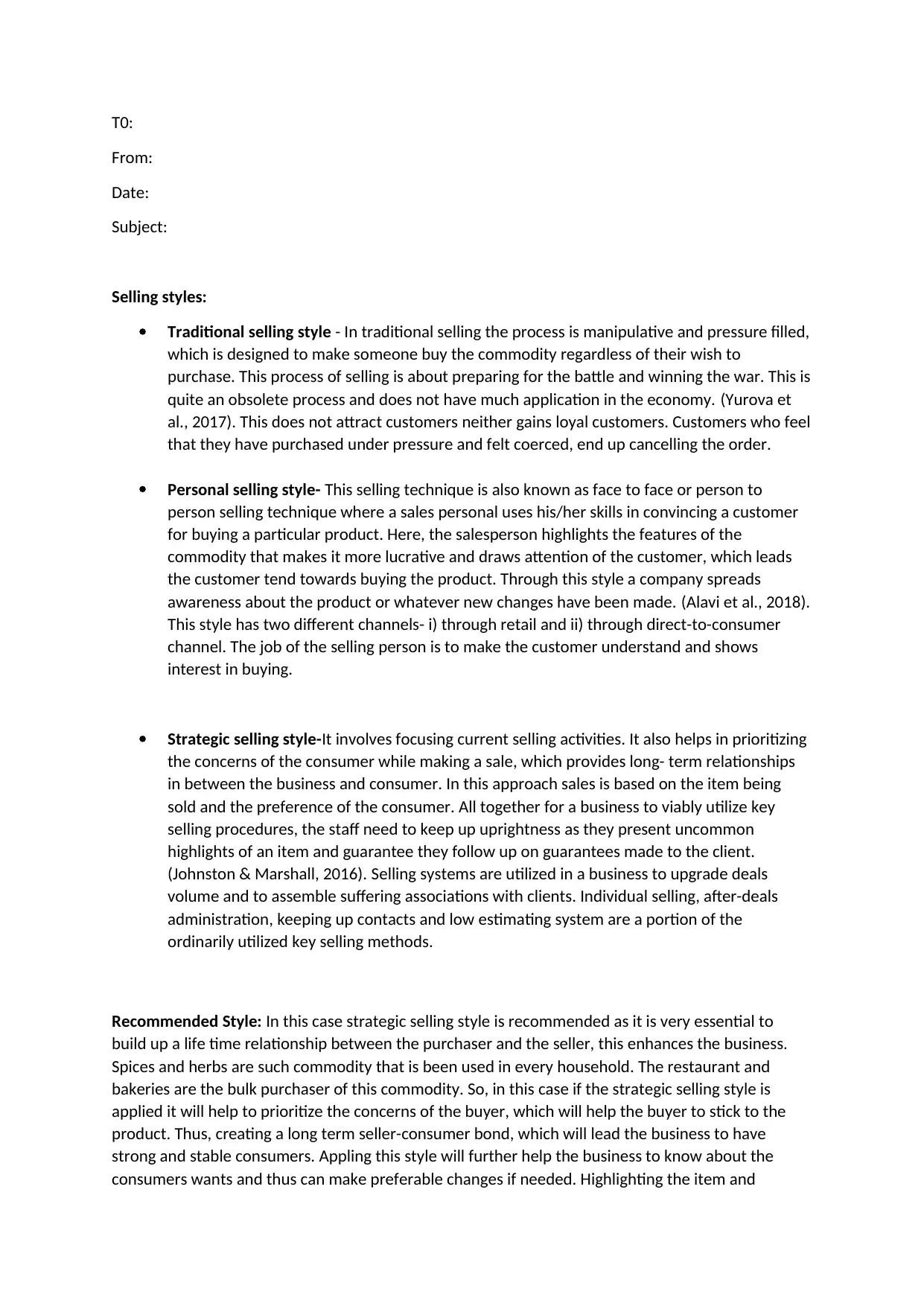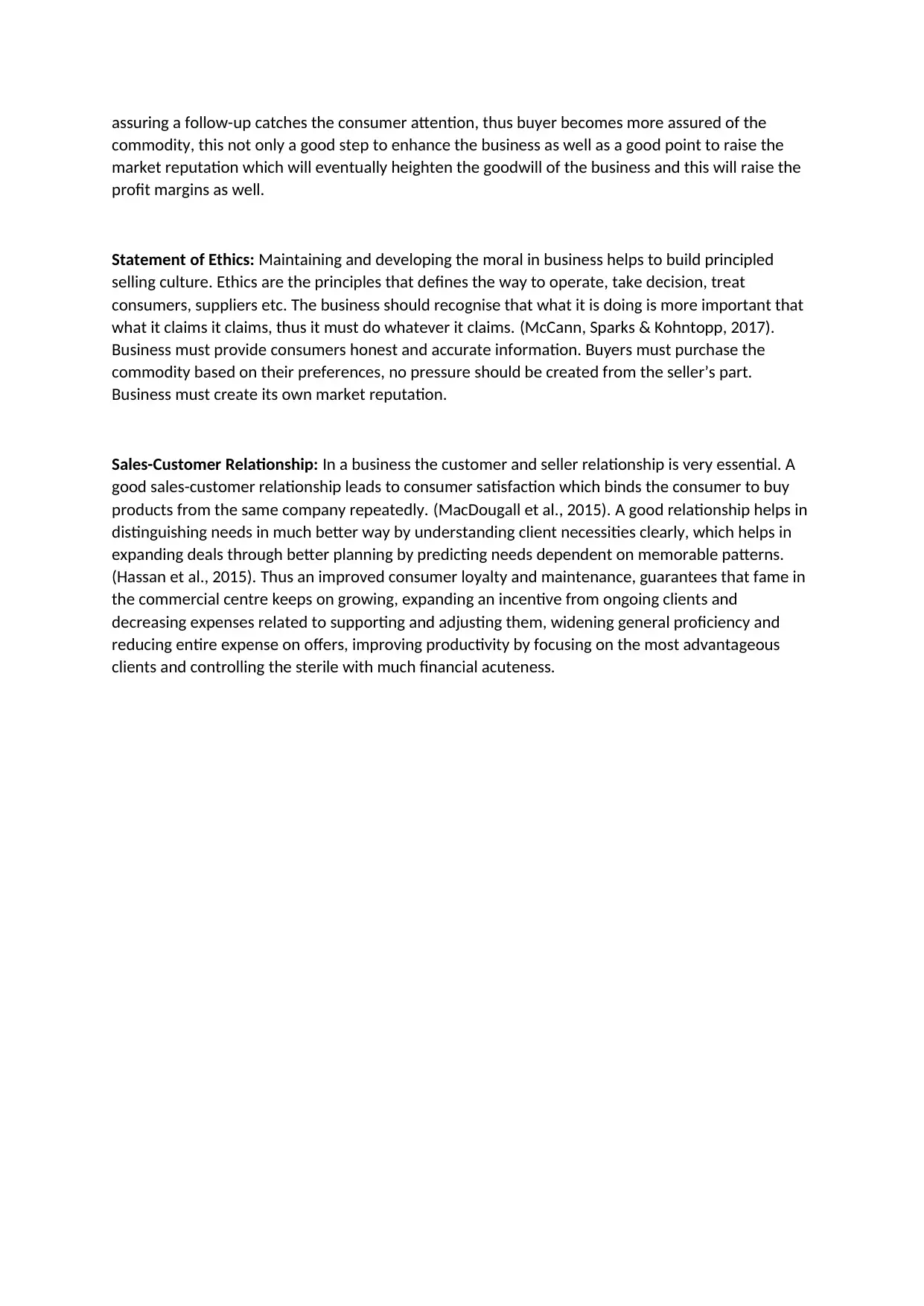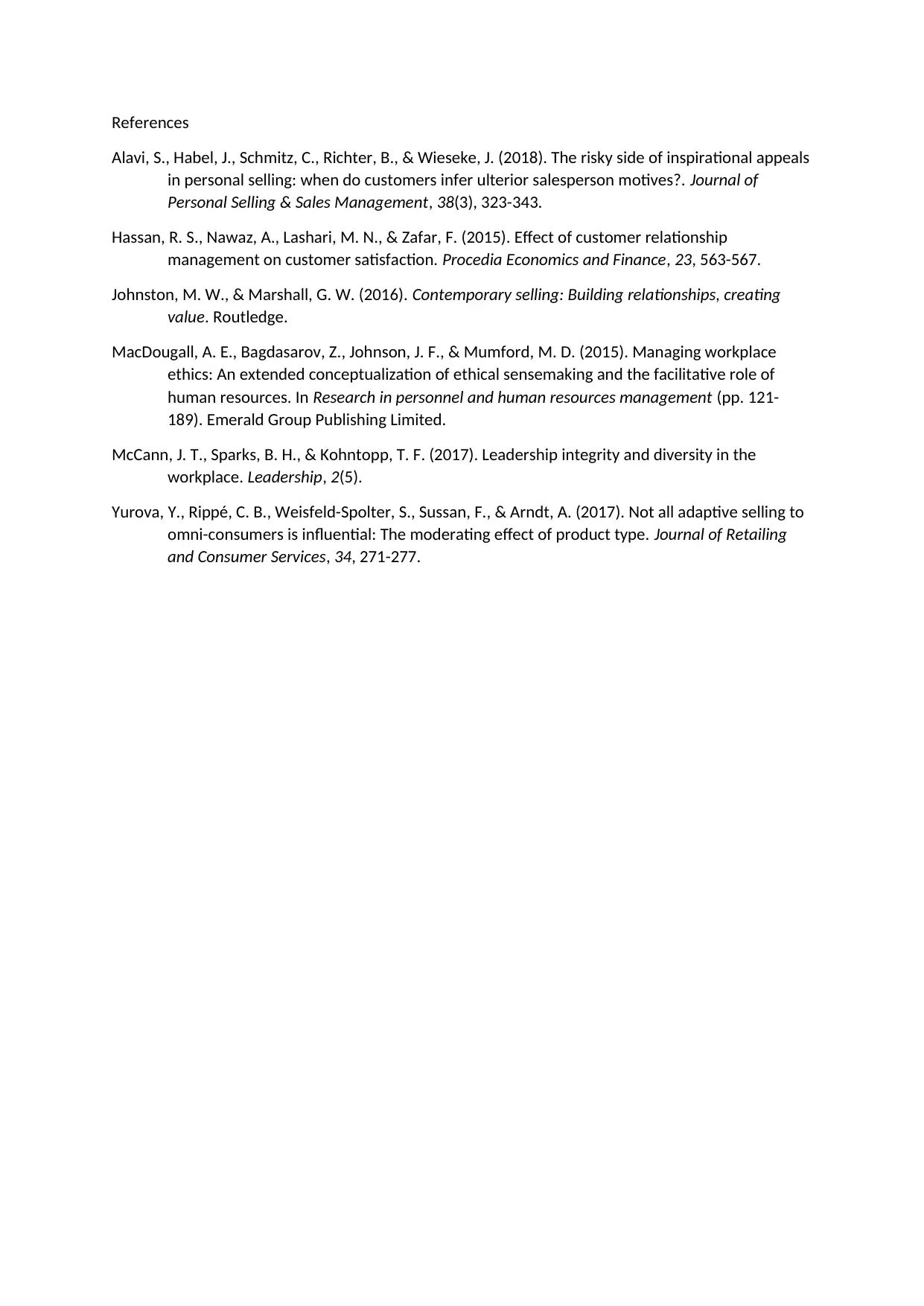Marketing Report: Selling Styles, Ethics, and Relationships
VerifiedAdded on 2022/11/18
|3
|1117
|225
Report
AI Summary
This report provides an analysis of three selling styles: traditional, personal, and strategic. It critiques the manipulative nature of traditional selling, which is considered obsolete, and highlights the benefits of personal selling, which involves face-to-face interaction to promote products. The report recommends a strategic selling style, which prioritizes long-term relationships by focusing on customer concerns and preferences. It emphasizes the importance of business ethics, including providing honest information and avoiding pressure tactics. The report also stresses the significance of sales-customer relationships in building consumer satisfaction and loyalty, which leads to increased sales and a positive market reputation. The strategic selling style is recommended for spices and herbs businesses, aiming to build long-term relationships and understand consumer needs. The report concludes that maintaining ethics and a good customer relationship is essential for business success and profitability.

T0:
From:
Date:
Subject:
Selling styles:
Traditional selling style - In traditional selling the process is manipulative and pressure filled,
which is designed to make someone buy the commodity regardless of their wish to
purchase. This process of selling is about preparing for the battle and winning the war. This is
quite an obsolete process and does not have much application in the economy. (Yurova et
al., 2017). This does not attract customers neither gains loyal customers. Customers who feel
that they have purchased under pressure and felt coerced, end up cancelling the order.
Personal selling style- This selling technique is also known as face to face or person to
person selling technique where a sales personal uses his/her skills in convincing a customer
for buying a particular product. Here, the salesperson highlights the features of the
commodity that makes it more lucrative and draws attention of the customer, which leads
the customer tend towards buying the product. Through this style a company spreads
awareness about the product or whatever new changes have been made. (Alavi et al., 2018).
This style has two different channels- i) through retail and ii) through direct-to-consumer
channel. The job of the selling person is to make the customer understand and shows
interest in buying.
Strategic selling style-It involves focusing current selling activities. It also helps in prioritizing
the concerns of the consumer while making a sale, which provides long- term relationships
in between the business and consumer. In this approach sales is based on the item being
sold and the preference of the consumer. All together for a business to viably utilize key
selling procedures, the staff need to keep up uprightness as they present uncommon
highlights of an item and guarantee they follow up on guarantees made to the client.
(Johnston & Marshall, 2016). Selling systems are utilized in a business to upgrade deals
volume and to assemble suffering associations with clients. Individual selling, after-deals
administration, keeping up contacts and low estimating system are a portion of the
ordinarily utilized key selling methods.
Recommended Style: In this case strategic selling style is recommended as it is very essential to
build up a life time relationship between the purchaser and the seller, this enhances the business.
Spices and herbs are such commodity that is been used in every household. The restaurant and
bakeries are the bulk purchaser of this commodity. So, in this case if the strategic selling style is
applied it will help to prioritize the concerns of the buyer, which will help the buyer to stick to the
product. Thus, creating a long term seller-consumer bond, which will lead the business to have
strong and stable consumers. Appling this style will further help the business to know about the
consumers wants and thus can make preferable changes if needed. Highlighting the item and
From:
Date:
Subject:
Selling styles:
Traditional selling style - In traditional selling the process is manipulative and pressure filled,
which is designed to make someone buy the commodity regardless of their wish to
purchase. This process of selling is about preparing for the battle and winning the war. This is
quite an obsolete process and does not have much application in the economy. (Yurova et
al., 2017). This does not attract customers neither gains loyal customers. Customers who feel
that they have purchased under pressure and felt coerced, end up cancelling the order.
Personal selling style- This selling technique is also known as face to face or person to
person selling technique where a sales personal uses his/her skills in convincing a customer
for buying a particular product. Here, the salesperson highlights the features of the
commodity that makes it more lucrative and draws attention of the customer, which leads
the customer tend towards buying the product. Through this style a company spreads
awareness about the product or whatever new changes have been made. (Alavi et al., 2018).
This style has two different channels- i) through retail and ii) through direct-to-consumer
channel. The job of the selling person is to make the customer understand and shows
interest in buying.
Strategic selling style-It involves focusing current selling activities. It also helps in prioritizing
the concerns of the consumer while making a sale, which provides long- term relationships
in between the business and consumer. In this approach sales is based on the item being
sold and the preference of the consumer. All together for a business to viably utilize key
selling procedures, the staff need to keep up uprightness as they present uncommon
highlights of an item and guarantee they follow up on guarantees made to the client.
(Johnston & Marshall, 2016). Selling systems are utilized in a business to upgrade deals
volume and to assemble suffering associations with clients. Individual selling, after-deals
administration, keeping up contacts and low estimating system are a portion of the
ordinarily utilized key selling methods.
Recommended Style: In this case strategic selling style is recommended as it is very essential to
build up a life time relationship between the purchaser and the seller, this enhances the business.
Spices and herbs are such commodity that is been used in every household. The restaurant and
bakeries are the bulk purchaser of this commodity. So, in this case if the strategic selling style is
applied it will help to prioritize the concerns of the buyer, which will help the buyer to stick to the
product. Thus, creating a long term seller-consumer bond, which will lead the business to have
strong and stable consumers. Appling this style will further help the business to know about the
consumers wants and thus can make preferable changes if needed. Highlighting the item and
Paraphrase This Document
Need a fresh take? Get an instant paraphrase of this document with our AI Paraphraser

assuring a follow-up catches the consumer attention, thus buyer becomes more assured of the
commodity, this not only a good step to enhance the business as well as a good point to raise the
market reputation which will eventually heighten the goodwill of the business and this will raise the
profit margins as well.
Statement of Ethics: Maintaining and developing the moral in business helps to build principled
selling culture. Ethics are the principles that defines the way to operate, take decision, treat
consumers, suppliers etc. The business should recognise that what it is doing is more important that
what it claims it claims, thus it must do whatever it claims. (McCann, Sparks & Kohntopp, 2017).
Business must provide consumers honest and accurate information. Buyers must purchase the
commodity based on their preferences, no pressure should be created from the seller’s part.
Business must create its own market reputation.
Sales-Customer Relationship: In a business the customer and seller relationship is very essential. A
good sales-customer relationship leads to consumer satisfaction which binds the consumer to buy
products from the same company repeatedly. (MacDougall et al., 2015). A good relationship helps in
distinguishing needs in much better way by understanding client necessities clearly, which helps in
expanding deals through better planning by predicting needs dependent on memorable patterns.
(Hassan et al., 2015). Thus an improved consumer loyalty and maintenance, guarantees that fame in
the commercial centre keeps on growing, expanding an incentive from ongoing clients and
decreasing expenses related to supporting and adjusting them, widening general proficiency and
reducing entire expense on offers, improving productivity by focusing on the most advantageous
clients and controlling the sterile with much financial acuteness.
commodity, this not only a good step to enhance the business as well as a good point to raise the
market reputation which will eventually heighten the goodwill of the business and this will raise the
profit margins as well.
Statement of Ethics: Maintaining and developing the moral in business helps to build principled
selling culture. Ethics are the principles that defines the way to operate, take decision, treat
consumers, suppliers etc. The business should recognise that what it is doing is more important that
what it claims it claims, thus it must do whatever it claims. (McCann, Sparks & Kohntopp, 2017).
Business must provide consumers honest and accurate information. Buyers must purchase the
commodity based on their preferences, no pressure should be created from the seller’s part.
Business must create its own market reputation.
Sales-Customer Relationship: In a business the customer and seller relationship is very essential. A
good sales-customer relationship leads to consumer satisfaction which binds the consumer to buy
products from the same company repeatedly. (MacDougall et al., 2015). A good relationship helps in
distinguishing needs in much better way by understanding client necessities clearly, which helps in
expanding deals through better planning by predicting needs dependent on memorable patterns.
(Hassan et al., 2015). Thus an improved consumer loyalty and maintenance, guarantees that fame in
the commercial centre keeps on growing, expanding an incentive from ongoing clients and
decreasing expenses related to supporting and adjusting them, widening general proficiency and
reducing entire expense on offers, improving productivity by focusing on the most advantageous
clients and controlling the sterile with much financial acuteness.

References
Alavi, S., Habel, J., Schmitz, C., Richter, B., & Wieseke, J. (2018). The risky side of inspirational appeals
in personal selling: when do customers infer ulterior salesperson motives?. Journal of
Personal Selling & Sales Management, 38(3), 323-343.
Hassan, R. S., Nawaz, A., Lashari, M. N., & Zafar, F. (2015). Effect of customer relationship
management on customer satisfaction. Procedia Economics and Finance, 23, 563-567.
Johnston, M. W., & Marshall, G. W. (2016). Contemporary selling: Building relationships, creating
value. Routledge.
MacDougall, A. E., Bagdasarov, Z., Johnson, J. F., & Mumford, M. D. (2015). Managing workplace
ethics: An extended conceptualization of ethical sensemaking and the facilitative role of
human resources. In Research in personnel and human resources management (pp. 121-
189). Emerald Group Publishing Limited.
McCann, J. T., Sparks, B. H., & Kohntopp, T. F. (2017). Leadership integrity and diversity in the
workplace. Leadership, 2(5).
Yurova, Y., Rippé, C. B., Weisfeld-Spolter, S., Sussan, F., & Arndt, A. (2017). Not all adaptive selling to
omni-consumers is influential: The moderating effect of product type. Journal of Retailing
and Consumer Services, 34, 271-277.
Alavi, S., Habel, J., Schmitz, C., Richter, B., & Wieseke, J. (2018). The risky side of inspirational appeals
in personal selling: when do customers infer ulterior salesperson motives?. Journal of
Personal Selling & Sales Management, 38(3), 323-343.
Hassan, R. S., Nawaz, A., Lashari, M. N., & Zafar, F. (2015). Effect of customer relationship
management on customer satisfaction. Procedia Economics and Finance, 23, 563-567.
Johnston, M. W., & Marshall, G. W. (2016). Contemporary selling: Building relationships, creating
value. Routledge.
MacDougall, A. E., Bagdasarov, Z., Johnson, J. F., & Mumford, M. D. (2015). Managing workplace
ethics: An extended conceptualization of ethical sensemaking and the facilitative role of
human resources. In Research in personnel and human resources management (pp. 121-
189). Emerald Group Publishing Limited.
McCann, J. T., Sparks, B. H., & Kohntopp, T. F. (2017). Leadership integrity and diversity in the
workplace. Leadership, 2(5).
Yurova, Y., Rippé, C. B., Weisfeld-Spolter, S., Sussan, F., & Arndt, A. (2017). Not all adaptive selling to
omni-consumers is influential: The moderating effect of product type. Journal of Retailing
and Consumer Services, 34, 271-277.
⊘ This is a preview!⊘
Do you want full access?
Subscribe today to unlock all pages.

Trusted by 1+ million students worldwide
1 out of 3
Related Documents
Your All-in-One AI-Powered Toolkit for Academic Success.
+13062052269
info@desklib.com
Available 24*7 on WhatsApp / Email
![[object Object]](/_next/static/media/star-bottom.7253800d.svg)
Unlock your academic potential
Copyright © 2020–2025 A2Z Services. All Rights Reserved. Developed and managed by ZUCOL.



